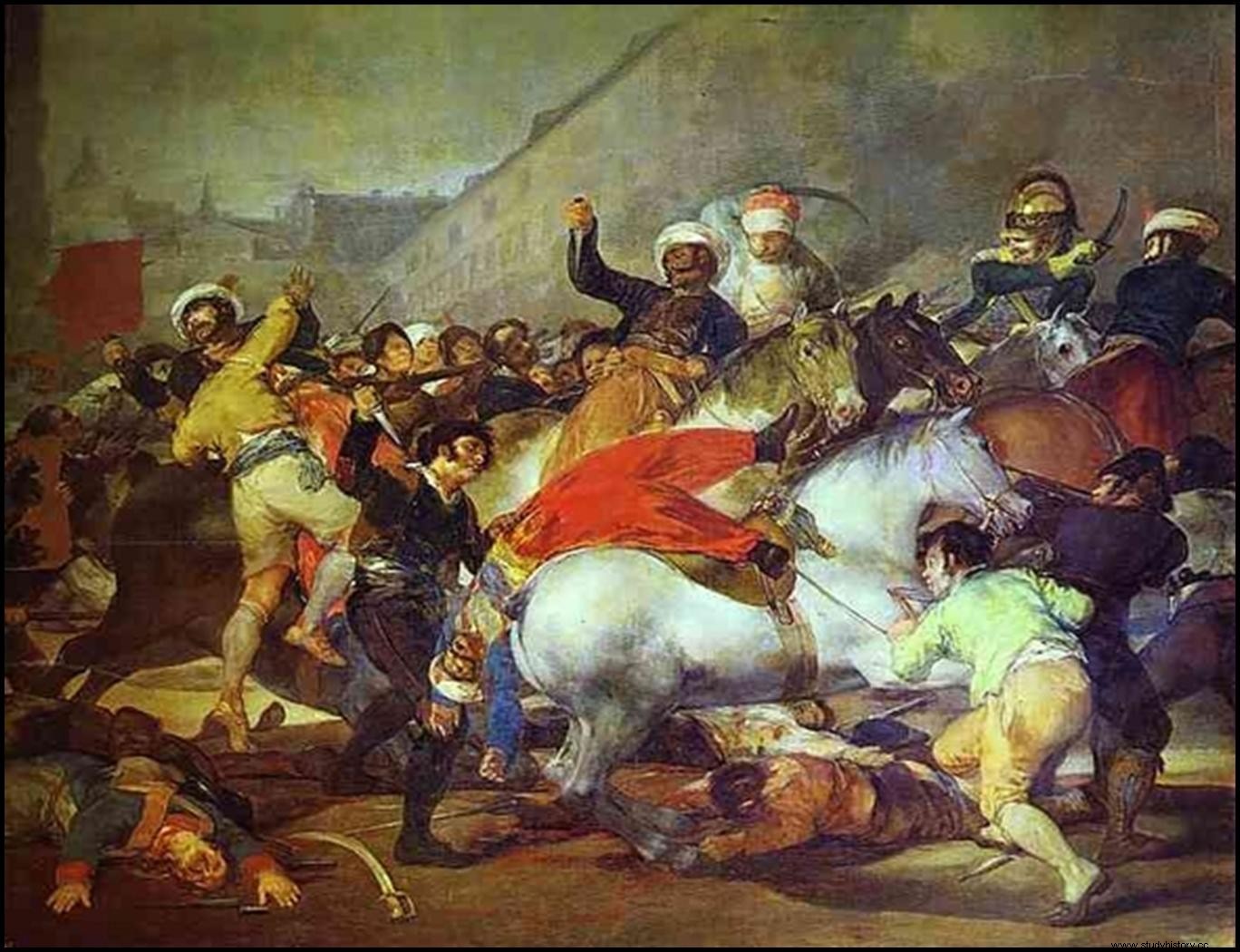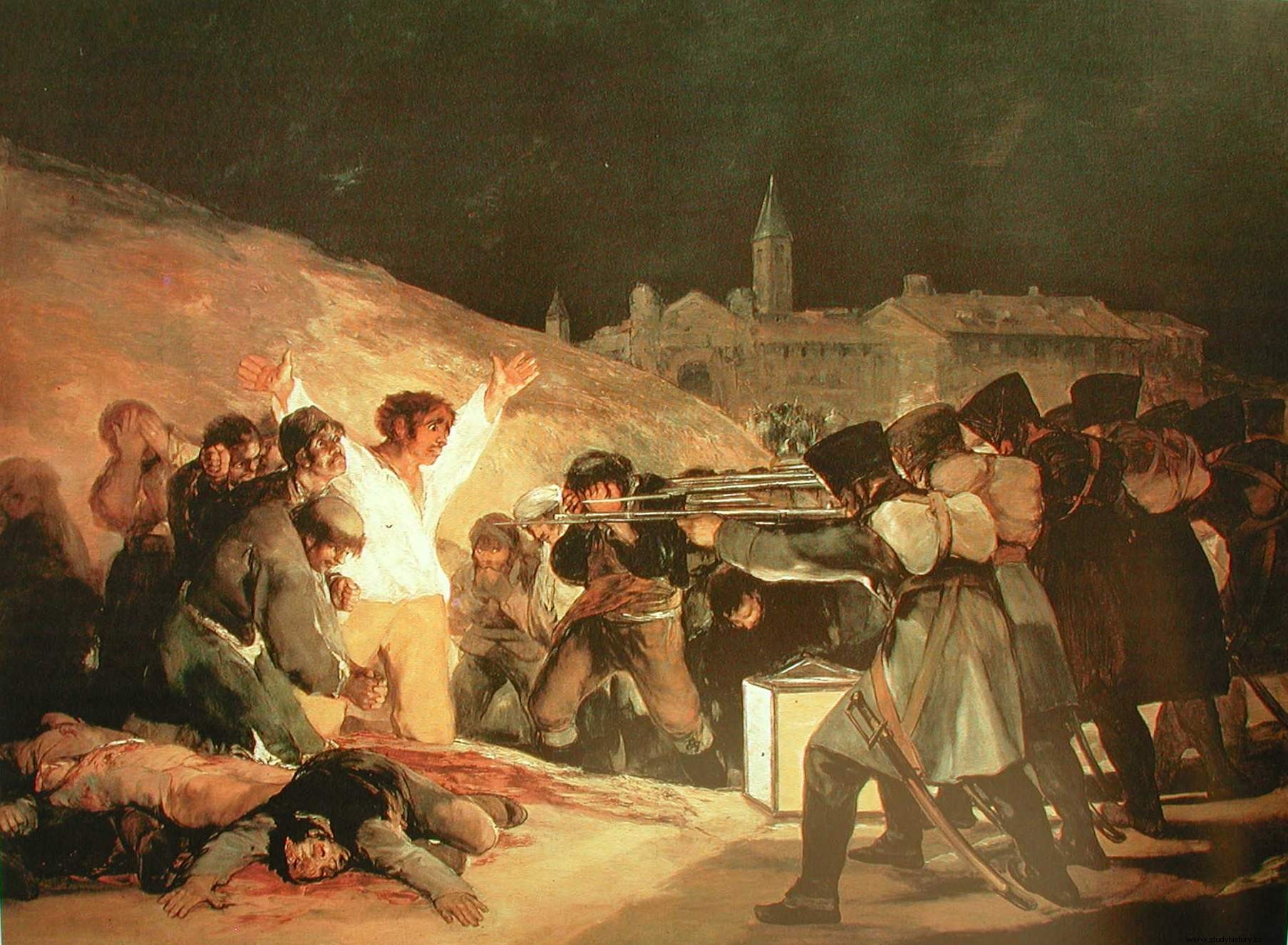Background :
In 1807, France and Spain signed the Treaty of Fontainebleau . They agree on the distribution of Portugal (an ally of England) between the two powers. Controlled the sea by the English and the Portuguese, the only option was for the French troops to cross the peninsula, so numerous French military contingents entered Spain. Napoleon, aware of the political crisis of the Bourbon regime, decided to take advantage of the situation.
In the court of King Carlos IV (fool, henpecked and cuckold), whose government was exercised in practice by Godoy -lover of the queen-, there was a group of conspirators, led by his son Fernando. This group was headed by the most reactionary sectors and those dissatisfied with Godoy. This situation led to the Aranjuez riot (March 17, 1808). The conspiracy of the court, a weak king, Godoy fallen into disgrace and popular protest forced the king to cede the throne to his son Fernando VII (the worst king in history). Nothing changed in Spain, the king was a puppet in the hands of Murat and his military troops. Ferdinand VII is called to Bayonne to meet with Napoleon. The king, eager for the emperor to recognize him, leaves for Bayonne, leaving control of the nation to the Supreme Government Junta. Murat asks the Governing Board to hand over Godoy, at first he refuses but finally has to give in. On April 30, Napoleon meets Carlos IV, Godoy and Fernando VII in Bayonne. Napoleon controls Spain (or so he thought).
Uprising of May 2 :
Around eight in the morning of May 2, two cars were stopped at the gates of the Royal Palace of Madrid, there were many people in the surroundings, since it was market day. In the first of them, people saw the queen of Etruria (María Luisa, daughter of Carlos IV) get on, and in the second car, people thought it was for the infante Francisco de Paula. At that moment, the teacher José Blas Molina shouted:
Betrayal!
Many joined the teacher shouting:
They want to take the infant
They released the horses and entered the Palace, where the infant greeted the crowd. The revolt had broken out. Murat sent companies of Imperial Guard grenadiers accompanied by 2 artillery pieces that littered the ground with corpses. Throughout Madrid, isolated Frenchmen were murdered and, in Puerta del Sol, hundreds of Madrilenians gathered. The mamelukes, cuirassiers and dragons arrived there and stabbed the crowd, this further inflamed the fury and hatred of the people of Madrid.
The insurgents went to the Monteleón Artillery Park, where some artillerymen and two captains, Daoiz and Velarde Ignoring the orders of his superior, General Negrete, they joined the rebels. They heroically defended the park, but in the end it was taken by storm by the French. Madrid had been the sad protagonist of a pitched battle between two unequal armies:one made up of elite French troops and the other made up of the common people of Madrid.

Charge of the Mamluks (Goya)
Murat found the perfect excuse to occupy the capital. He acted ruthlessly and violently. He confirmed General Negrete's quartering order (thus he controlled the Spanish army) and punished the rebels with death sentences. We reproduce the proclamation published in the Madrid Gazette on May 6:
Art. I:Tonight, General Grouchy will convene the military commission.
Art. II:All those who have been imprisoned with weapons during the rebellion will be shot.
Art. III:The Governing Board is going to order the residents of Madrid to be disarmed. All the residents of the Court, who after the time prescribed for the execution of this resolution, carry weapons, or keep them in their home without a special license, will be shot.
Art. IV:Any group that exceeds eight people will be considered a meeting of rebels and will be shot.
Art. V:Every village or hillside where a Frenchman is murdered will be set on fire.
Art. VI:The masters will be responsible for their servants, the factory owners for their officials, the parents for their children, and the prelates of the convents for their religious.
Art. VII:The authors of printed or handwritten libels that cause sedition, those who distribute or sell them, will be considered agents of England and as such passed by arms.
Given at our headquarters in Madrid, on May 2, 1808.

Executions of May 3 (Goya)
Madrid was the fuse that lit the revolt, but that same afternoon, fugitives from Madrid brought the news of what had happened in the capital. Andrés Torrejón and Simón Hernández , mayors of Móstoles, issued a proclamation to their neighbors urging them to take up arms (Bando de Independencia ):
Gentlemen justices of the towns to whom this office is presented, from me the ordinary mayor of the town of Móstoles.
It is well known that the French stationed in the vicinity of Madrid, and inside the Court, have taken the offense on this capital town and the Spanish troops; so that in Madrid at this time a lot of blood is flowing. We are Spaniards and it is necessary that we die for the king and for the country, arming ourselves against some perfidious who, under the guise of friendship and alliance, want to impose a heavy yoke on us, after having seized the august person of the king. Proceed your mercedes, then, to take the most active steps to punish such perfidy, going to the aid of Madrid and other towns, and enlisting us, because there is no force that prevails against those who are loyal and brave, as the Spaniards are.
God keep your mercedes for many years.
Móstoles, May 2, 1808.
Andrés Torrejón
Simón Hernández
It was the first declaration of war against the invading army and was made by the mayors.
